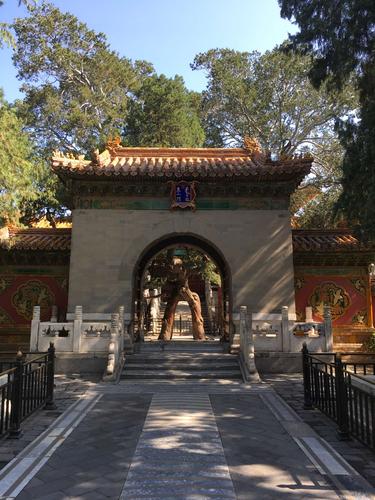
The Imperial Garden
Booking Tickets to the Forbidden City
Located just beyond the Gate of Tranquil Longevity, the Imperial Garden was built in 1417 during the Ming Dynasty. Rectangular in shape, it covers an area of approximately 12,000 square meters. As the private retreat for the royal family, it is one of the most typical examples of Chinese imperial garden design. More than 20 structures, each in a different style, are scattered throughout the garden. These structures, together with the trees, rockeries, flowerbeds, and sculptures such as bronze incense burners, provide visitors with a visual feast and endless amazement. It’s a marvel of the designer’s art to achieve so much in such a compact space.
Hall of Imperial Peace
The most important structure in the garden is the Hall of Imperial Peace, which occupies the central position. It is surrounded by a wall, dating back to the 15th century. In front of the hall grows a 400-year-old pine tree. This pine tree, called the “Concubine Pine”, symbolizes the harmony between the emperor and the empress. Two gilded unicorns guard the entrance to the hall and protect it from evil spirits. Inside the hall, people offered prayers to the Taoist God of Water, Xuan Wu, for his protection of the Forbidden City from fire.
Pavilion of Myriad Springs
Pavilion of Floating Emerald
Floating Emerald Boat (Boat of Abundant Splendor)
Imperial Garden Photos
Four pavilions, one in each corner of the garden, symbolize the four seasons. The most notable is the Pavilion of Myriad Springs, situated in the east corner. Built in 1535 and renovated during the Qing Dynasty, this pavilion, as its name suggests, symbolizes spring.
Pavilions in the Imperial Garden
In the northeast, on top of the 堆秀山 (Dui Xiu Shan, or Mound for Piling Elegant Rocks), is the Gathering Beauty Hill, a man-made hillock with a grotto. On the hilltop sits the Imperial View Palace (御景亭), where emperors throughout the dynasties would ascend on the Double Ninth Festival to enjoy the scenery.
Incense Burners
Incense Burner
Imperial Garden
Forbidden City Imperial Garden
Visitors will see pathways paved with colorful pebbles in different patterns, symbolizing good luck and fortune. Observant visitors will notice a set of pictures depicting wives punishing their husbands. It may seem strange to have such pictures here in feudal China, a time when men were dominant, especially the all-powerful emperor!
At the northern end of the garden lies the Gate of Divine Might (Shenwu Men), the “back door” of the Forbidden City. You can exit through this gate after you finish visiting all the attractions in the eastern and western sides of the Inner Court.
FAQs
1. What is the significance of the Imperial Garden's design?
The Imperial Garden's design is a microcosm of the Chinese universe, embodying harmony, balance, and the emperor's connection to the cosmos. The arrangement of structures, plants, and water features reflects these principles, creating a space of tranquility and contemplation for the royal family.
2. What is the historical importance of the Hall of Imperial Peace?
The Hall of Imperial Peace served as a place for religious ceremonies and offerings to deities, particularly Xuan Wu, the God of Water. Its central location and architectural prominence highlight its importance in protecting the Forbidden City from fire and ensuring the well-being of the imperial family.
3. What is the symbolism of the colorful pebbles in the garden pathways?
The colorful pebbles are not merely decorative but carry symbolic meaning. The patterns and colors represent good fortune, wealth, and longevity, reflecting the auspicious nature of the Imperial Garden as a place of imperial blessings.
note: This return of all, without the author's permission, may not be reproduced